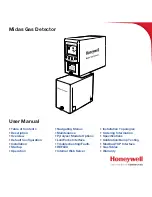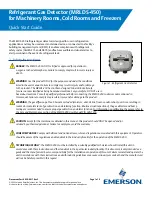
Midas
®
Gas Detector
2-4
2.2.1 Mounting Bracket
The metal mounting bracket has two slots that allow
the detector to be easily mounted to a wall using
two suitable screws (DIN rail or horizontal mounting
options are also available). For further details of
mounting the detector refer to
Section 4
.
2.2.2 Terminal Module
The terminal module is located on the mounting
bracket. All electrical connections to Midas
®
are
made via this module. Wire entry to the terminal
module area is via the PG16 cable entry/conduit
entry located at the bottom of the mounting bracket
assembly.
2.3 Sensor Cartridge
A wide range of Flammable, Pyrophoric, Corrosive,
and Oxidizer (including Oxygen) sensor cartridges
can be fitted to Midas
®
. The plug in sensor cartridges
are fitted in the sensor cartridge chamber at the
front of the main chassis. To access the chamber
the unit cover is removed by unscrewing the
thumbscrew located at the front of the detector. The
pre-calibrated smart sensor cartridges can easily
be fitted or replaced as they simply plug into the
detector without the need for any tools. The sensor
cartridge is firmly held in place by two locking tabs.
Some cartridges are shipped with a protective cap
to shield them from contaminants during shipping.
This cap must be removed before inserting the
cartridge into the Midas
®
unit, failure to do so may
damage the Midas
®
transmitter.
Diagram 2-5. Sensor cartridge
REMOVE
AT TIME OF
INSTALLA
TION
Front
Back
Connector
Locking tabs
Protective Cap
(remove before use)
2.3.1 Biased Sensor Cartridges
Some sensor cartridges are shipped with a battery
powered electrical supply in order to keep the cell
effectively ‘warmed up’ and ready to monitor once
installed in the Midas
®
unit. Battery powered bias
circuits are supplied for TEOS, NO, and CO
2
. The
bias circuit is removed just before insertion into
the Midas
®
system and the sensor cartridge is thus
ready sooner for effective gas detection.
Should a bias voltage not be applied (e.g. during
a power failure), the cell will take a longer time to
recover before effective gas detection can take
place. The longer the loss of applied power, the
longer the recovery time. During this recovery time,
there is a chance for false/inaccurate readings.
Refer to the relevant sensor cartridge data sheet for
information on each sensor cartridge.
In order to avoid the risk of loss of gas detection
due to unforeseen power loss, we recommend that a
power management solution such as uninterruptible
power supplies are used.
Summary of Contents for Midas
Page 7: ...Midas Gas Detector 1 1 1 Description ...
Page 9: ...Midas Gas Detector 2 1 2 Overview ...
Page 14: ...Midas Gas Detector 3 1 3 Default Configuration ...
Page 17: ...Midas Gas Detector 4 1 4 Installation ...
Page 41: ...Midas Gas Detector 5 1 5 Startup ...
Page 43: ...Midas Gas Detector 6 1 6 Operation ...
Page 53: ...Midas Gas Detector 7 1 7 Navigating Modes and Submenus ...
Page 74: ...Midas Gas Detector 8 1 8 Maintenance ...
Page 82: ...Midas Gas Detector 9 1 9 Pyrolyzer Module Options ...
Page 89: ...Midas Gas Detector 10 1 10 Optional LonWorks Interface Installation ...
Page 99: ...Midas Gas Detector 11 1 11 Troubleshooting and Fault Diagnosis ...
Page 102: ...Midas Gas Detector 12 1 12 REFLEX ...
Page 104: ...Midas Gas Detector 13 1 13 Internal Web Server ...
Page 106: ...Midas Gas Detector 13 3 Diagram 13 1 IPAddress setting in Windows XP ...
Page 129: ...Midas Gas Detector 14 1 14 Typical Installation Topologies ...
Page 132: ...Midas Gas Detector 15 1 15 Ordering Information ...
Page 136: ...Midas Gas Detector 16 1 16 Specifications ...
Page 139: ...Midas Gas Detector 17 1 17 Calibration and Bump Testing ...
Page 143: ...Midas Gas Detector A 1 A Modbus TCP Interface ...
Page 150: ...Midas Gas Detector B 1 B Gas Tables ...
Page 158: ...Midas Gas Detector C 1 C Warranty ...













































